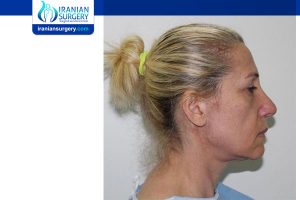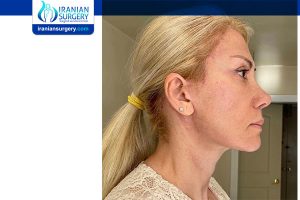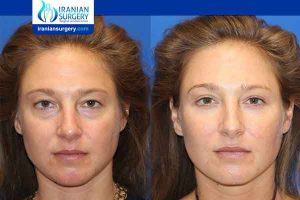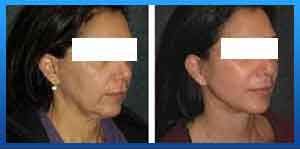
How much does Facelift Surgery cost in Iran?
Procedure | Prices |
Facelift (Complete) | 1800 – 3500 US$ |
Mid-Face Lift ( Endoscopical ) | 1200 – 2500 US$ |
Full Facelift Cost in Iran,Tehran at 2022 :
Full Facelift Cost in Iran Tehran at 2022 is around usd 3500 usd which is affordable compare to other countries.Face is an important part of the body that is why its very important to chose best doctor.
Full Facelift Cost in Iran,Shiraz at 2022 :
Full Face lift Cost in Iran,Shiraz at 2022 is around usd 2700 usd which its being done at the best hospital with newest methods of Surgery by the best Doctors.
A cosmetic procedure that has become very popular these days is facelift surgery.
This procedure will bring you the beauty you have always dreamed of and make look much younger than you actually are.
Facelift surgery will boost your self-confidence and enhance your appearance.
The team of surgeons at Iranian Surgery perform more than 20,000 cosmetic surgeries every year for both domestic and foreign patients. And such a large volume of surgeries has helped our surgeons become highly experienced and fully aware of international needs and tastes for surgeries. Offering high quality medical services at a low price has turned Iran into the perfect destination for these cosmetic procedures.
By making your stay in Iran as comfortable and enjoyable as possible and giving you the highest quality medical services along the way, the Iranian Surgery team has been able to create a lasting competition with all countries. All the patients who undergo more than two cosmetic surgeries or choose to receive a full facelift, will enjoy a 20% discount offered by the Iranian Surgery medical team.
Facelift surgery in Iran Review

The cost of a facelift Surgery in Iran is between $700-3000 which can be differs in different beauty centers. The cost depends on the type of facelift to be carried out. The facelift cost in Iran also depends on the techniques to be used, the experience of the plastic surgeon and the location.
On average, facelift surgery cost in Iran is around $1750 (With best plastic surgeon). The minimum face lift cost in Iran is $ 700 ( Mini facelift : Eyelid ) and the maximum face lift surgery cost (full face lift surgery) is $ 3000.

Before facelift surgery in Iran

Free Consultation
Read more about : The Swedish patient saved $ 90,000 by choosing Iran over the United States to have leg lengthening surgery.
Read more about : Facelift surgery in Iran Before and after
Read more about : Rhinoplasty in Iran before and after
Read more about : Buccal Fat Removal
Read more about : 5 Days after mini facelift
Read more about : Facial Feminization Surgery
After facelift surgery in Iran
If you decide to have a Facelift surgery in Iran, reading this article can improve your knowledge about cost of Facelift to a great extent and help you to choose the best plastic surgeons and hospital to perform Facelift surgery in Iran.

Dr. Afshan shah
Cosmetic surgery consultant
Dr. Afshan Shah is one of the most experienced cosmetic surgeons in Iran. She graduated from Shahed University of Medical Science in 2004.
Dr. Afshan Shah has published numerous medical articles and produced many podcasts, and educational videos. She has mostly performed cosmetic surgeries, including Facelift , blepharoplasty ,Abdominoplasty (tummy tuck), Liposuction, Lipomatic, BBl, Breast reduction and Breast augmentation, Breast lift and to name but a few.
Read more about : Best plastic surgeons in Iran
Read more Read : Rhinoplasty surgery , Before and after surgery Videos
Read more about : Rhinoplasty podcast with Dr Afshan shah
_____________________________________________________________________________________________
Plan your Facelift surgery in Iran with the Best plastic Surgeon.
Iranian Surgery is a medical tourism company in Iran that cooperates with the best plastic surgeons, specialists and hospitals in Iran and offers world-class treatments at an affordable cost.

_________________________________________________________________________________________
Read more about : Belepharoplasty surgery , Before and after surgery Videos
Read more about : Belepharoplasty surgery , Before and after surgery Videos
Read more about : Lipomatic surgery , before and after surgery Video
Read more about : Abdominoplasty and Breast reduction and bbl surgery , before and after surgery videos

Why facelift surgery in Iran?
The high experience of facial cosmetic surgeons in Iran, on the one hand, and the affordable cost of facelift surgery (starting at $ 700 for Blepharoplasty ), on the other hand, has made Iran the first destination for cosmetic surgeries.The average cost of facial cosmetic surgery( face lift surgery) in Iran in 2021 is about $ 1,300, while the cost of facial cosmetic surgery in the United States and Turkey is 7,500 and $ 4,200, respectively. These are the reasons why people from all over the world come to Iran for facial cosmetic surgery.
In this article we provide you with a comprehensive description of Facelift in Iran, the cost of Facelift in Iran and the best Iranian Facelift surgeons.
Further, this article will explain the cost of the best Facelift and rhinoplasty surgeons in Iran and the cost of Facelift in Tehran, cost of Facelift in Shiraz and cost of Facelift in Mashhad.

Read more about : Nose job cost in Iran
General information about Facelift Surgery in Iran
The following table describes general information about Facelift surgery in Iran including Facelift cost in Iran, recovery time, and to name but a few.
General Information |
|
Cost | $ 700 – 3000 |
Anesthesia | General/ Local |
Hospital Stay | The same day |
Back to Work | 2 Weeks |
Duration of Operation | 2-5 Hours |
Minimum Stay in Iran | 7 Days |
Why Iranian surgery?
You need a professional medical tourism facilitator in Iran who can provide you with the best medical services. Fortunately, the size of our group allows us to provide intensive care for each patient. And we would like to inform you that in 2019 and 2020, more than 11,000 patients from 53 countries who planned to have cosmetic surgery in Iran received consultation from Iranian Surgery. Of these consultations, 280 facial cosmetic surgeries, 148 breast surgeries and 224 liposuction surgeries were performed with complete success under the supervision of the most experienced plastic surgeons in Iran.
About Iranian Surgery
Iranian surgery is an online medical tourism platform where you can find the best cosmetic Surgeons in Iran. All cosmetic surgeons working with Iranian Surgery specialize in plastic surgery and perform cosmetic surgeries in well-equipped hospitals, so after Facelift surgery in Iran you will face the least possible complications.
For more information about the cost of Facelift in Iran and to schedule an appointment in advance, you can contact Iranian Surgery consultants via WhatsApp number 0098 901 929 0946. This service is completely free.
Read more about : Cat eye surgery in Iran
All you should know about Facelift Surgery
What is Facelift?
A face-lift (rhytidectomy) is a cosmetic surgical procedure to create a younger appearance in your face. The procedure can reduce the sagging or folds of skin on the cheeks and jawline and other changes in the shape of your face that occur with age.
During a face-lift, a flap of skin on each side of the face is pulled back, and tissues below the skin are surgically altered to return the contour of the face to a more youthful shape. Before the flap is sutured closed, excess skin is removed.
A neck lift (platysmaplasty) is often done as part of a face-lift to reduce fat deposits and sagging skin on the neck.
Before Facelift Surgery
Why it’s done
As you get older, the appearance and shape of your face is altered because of normal age-related changes. Your skin becomes less elastic and looser, and fat deposits decrease in some areas of your face and increase in others. Age-related changes in your face that may be reduced with a face-lift include the following:
. Sagging appearance of your cheeks
. Excess skin at your lower jawline (jowls)
. Deepening of the fold of skin from the side of your nose to the corner of your mouth.
. Sagging skin and excess fat in the neck (if the procedure includes a neck lift)
A face-lift isn’t a treatment for superficial wrinkles, sun damage, creases around the nose and upper lip, or irregularities in skin color.
to consider a Facelift
. If you feel that your face does not reflect your youthful spirit and energy level
. If you determine that your facial sagging and excess skin is a social or career obstacle.
. If you show signs of facial aging but still have some skin elasticity
. One day you look in the mirror and realize that time, gravity, sun exposure and heredity have taken a toll and you simply do not look like yourself any more.
Who is a good candidate for a facelift surgery?
The following are some common facial characteristics that make you an appropriate candidate for a facelift:
. Sagging skin in your midface and/or jawline
. Deep creases extending from your nose to the corners of your mouth (nasolabial folds)
. Lines extending from each corner of your mouth down your chin (marionette lines).
. Facial fat (volume) that has fallen or is displaced
. Sagging and loss of muscle tone in the lower face, resulting in jowls
. A double chin, resulting from loose skin and excess fatty deposits under the chin and jaw.
. Creased and sagging skin in your neck
If you are in good general health, have a positive attitude and realistic expectations, you are most likely a good candidate for this procedure.
Advantages and Disadvantages of Facelift
Pros:
- A facelift can improve many areas of the face in one surgery
- Can last for ten years or more and can make you appear ten to fifteen years younger.
- Can recontour the neck and jawline better than all other techniques
Cons:
- A facelift will not create a ‘new’ you, just a younger version of yourself
- There will be some downtime associated with this procedure
- Depending on your age and skin type, you may want a secondary procedure later on.
These are the top three pros and cons to weigh when considering a facelift. If you want to focus on what is unique to you, please consult with your aesthetic plastic surgeon.
Read more about : Mini facelift
Risks and Complications
A face-lift surgery can cause complications. Some can be managed with appropriate care, medication or surgical correction. Long-term or permanent complications, while rare, can cause significant changes in appearance. The risks include:
Hematoma. A collection of blood (hematoma) under the skin that causes swelling and pressure is the most common complication of face-lift surgery. Hematoma formation, which usually occurs with 24 hours of surgery, is treated promptly with surgery to prevent damage to skin and other tissues.
Scarring. Incision scars from a face-lift are permanent but typically concealed by the hairline and natural contours of the face and ear. Rarely, incisions can result in raised, red scars. Injections of a corticosteroid medication or other treatments might be used to improve the appearance of scars.
Nerve injury. Injury to nerves, while rare, can temporarily or permanently affect nerves that control sensation or muscles. Temporary paralysis of a select muscle, resulting in an uneven facial appearance or expression, or temporary loss of sensation can last a few months to a year. Surgical interventions may offer some improvement.
Hair loss. You might experience temporary or permanent hair loss near the incision sites. Permanent hair loss can be addressed with surgery to transplant skin with hair follicles.
Skin loss. Rarely, a face-lift can interrupt the blood supply to your facial tissues. This can result in skin loss (sloughing). Sloughing is treated with medications, appropriate wound care and, if necessary, a procedure to minimize scarring.
Like any other type of major surgery, a face-lift poses a risk of bleeding, infection and an adverse reaction to anesthesia. Certain medical conditions or lifestyle habits also can increase your risk of complications. The following factors may present a significant risk or result in unfavorable results, and your doctor may advise against a face-lift.
Blood-thinning medications or supplements. Medications or supplements that thin the blood can affect your blood’s ability to clot and increase the risk of hematomas after surgery. These medications include blood thinners (Coumadin, Plavix, others), aspirin, nonsteroidal anti-inflammatory drugs (NSAIDs), ginseng, Ginkgo biloba, fish oil and others.
Medical conditions. If you have a medical condition that prevents blood clotting, you won’t be able to have a face-lift. Other conditions, such as poorly controlled diabetes or high blood pressure, increase the risk of poor wound healing, hematomas and heart complications.
Smoking. Smoking significantly increases the risk of poor wound healing, hematomas and skin loss after a face-lift.
Weight fluctuation. If you have a history of repeated weight gain and loss — factors that affect the shape of your face and condition of your skin — the outcome of the surgery may not be satisfactory or may be satisfactory for only a short time.
How you prepare
Initially, you’ll talk to a plastic surgeon about a face-lift. The visit will likely include:
- Medical history and exam. Prepare to answer questions about past and current medical conditions, previous surgeries, previous plastic surgeries, complications from previous surgeries, history of smoking, and drug or alcohol use. Your surgeon will do a physical exam, may request recent records from your doctor or order a consultation with a specialist if there are any concerns about your ability to undergo surgery.
- Medication review. Provide the name and dosages of all medications you regularly take, including prescription drugs, over-the-counter drugs, herbal medications, vitamins and other dietary supplements.
- Facial exam. Your plastic surgeon will take photos of your face from different angles and close-up photos of some features. The surgeon will also examine your bone structure, shape of your face, fat distribution and quality of your skin to determine your best options for face-lift surgery.
- Expectations. Your surgeon will ask questions about your expectations for the outcomes of a face-lift. He or she will help you understand how a face-lift will likely change your appearance and what a face-lift doesn’t address, such as fine wrinkles or naturally occurring asymmetry in your face.
Read more about : Forehead reduction surgery
Read more about : Forehead reduction without surgery
Before a face-lift:
Follow medication directions. You’ll receive instructions about what medications to stop taking and when to stop. For example, you’ll likely be asked to discontinue any blood-thinning medication or supplement at least two weeks before surgery. Talk to your doctor about what medications are safe to take or whether the dosage should be adjusted.
Wash your face and hair. You’ll likely be asked to wash your hair and face with a germicidal soap the morning of the surgery.
Avoid eating. You’ll be asked to avoid eating anything after midnight the night before your face-lift. You will be able to drink water and take medications that have been approved by your surgeon.
Arrange for help during recovery. If your face-lift is done as an outpatient procedure, make plans for someone to drive you home after surgery and stay with you the first night after surgery.
During Facelift Surgery
During the procedure
How is a facelift procedure performed?
In general, a face-lift involves elevating the skin and tightening the underlying tissues and muscles. Fat in the face and neck may be sculpted, removed or redistributed. Facial skin is then re-draped over the newly repositioned contours of the face, excess skin is removed, and the wound is stitched or taped closed.
There are several approaches to facelift surgery. Your plastic surgeon will recommend an approach based on your goals and facial characteristics, including the shape of your face. The placement and length of incisions vary, depending on the facelift technique that best suits you. Your surgeon might find you appropriate for a ‘short scar’ facelift procedure in which a short incision is usually limited to the area around the ear.
Facelift surgery is usually done as an outpatient procedure. It may involve a local anesthetics and sedatives or general anesthesia.
The procedure can take from 2 to 5 hours, and the person can normally go home on the same day after surgery.
Most facelift techniques focus on the lower facial areas, such as the jawline, jowls and cheeks. A facelift can also focus on the midface or the forehead. In some techniques, deeper facial tissues may be repositioned or tightened to restore a more youthful contour. In other techniques, removal or addition of fat or other soft-tissue fillers may be necessary to achieve the best results. Today, many different techniques exist with outcomes that can be consistently reliable, safe, and durable. Your incisions will depend on the area of the face that is targeted and the amount of change you want.
Once the incisions are made, various degrees of ‘undermining’ of your skin is performed, and the deeper layers of your face are lifted. Undermining separates the overlying skin of the face and neck from the muscles and tissues deep to the skin. This frees or loosens facial and neck skin so it can be redraped at the end of the procedure, making sure skin is smooth.
Then, your surgeon will raise the skin from the temples, cheeks, and neck, and lift and reposition the underlying connective tissue, removing excess fat and skin. If this procedure is performed in conjunction with a neck lift, the surgeon will draw the neck muscles together, stitching them together at the midline to form a strong sling of muscles that supports the entire neck and jaw. Your surgeon may also include liposuction of the neck and jowls. Facial implants may be added to increase cheek or chin volume.
Finally, your surgeon redrapes the skin over the new underlying structure and closes the incisions with stitches and/or small metal clips. Where needed, drainage tubes may be inserted. A padded, supportive dressing is usually applied.
The goal of your aesthetic plastic surgeon and the entire staff is to help you achieve the most beautiful and natural-looking results, and to make your surgical experience as easy and comfortable as possible.
Read more about : Hair transplant in Iran
Read more about : Lipomatic
Read more about : Liposuction in Iran
What will my facelift incisions and scars be like?
Regardless of the type of facelift you undergo, you will have incisions that involve the skin around your ear.
. Traditional facelift: Your surgeon will make incisions in your hairline at the temples, continuing down and around the front of your ears and hidden in the natural creases behind your ears in your lower hair-bearing scalp.
. Limited-incision facelift: Your surgeon will make short incisions in your hairline, starting at your temples and continuing down and around the front of your ears, hidden in the natural creases. There may also be incisions in the lower eyelids, temporal area, or under the upper lip.
. Neck lift: Your surgeon will make incisions starting in front of your earlobes and continuing around behind your ears in your lower scalp. There will also be a small incision underneath your chin.
Facelift scars can be virtually invisible: narrow, flat, and well placed behind the ear so you can wear your hair close-cropped.
Your board-certified surgeon will place the incision in areas that are hidden and in areas where the scars look like natural wrinkles. Incision healing depends on surgical technique, infection prevention, reduction of tension, your nutrition, any known or unknown underlying medical conditions, no smoking, and your genetic tendencies.
There is a risk of ‘hypertrophic scars’ and ‘keloids’ anytime the skin is cut. This risk is greater in darker-skinned people such as Blacks and Hispanics. Injections of a corticosteroid medication or other treatments, might be used to improve scar appearance.
Read more about : Rhinoplasty scars
After facelift Surgery
Aftercare and Recovery
What will my recovery and healing from a facelift be like?
Your surgeon will discuss how long it will be before you can return to your normal level of activity and work. After surgery, you and your caregiver will receive detailed instructions about your post-surgical care, including information about:
. Drains, if they have been placed
. Normal symptoms you will experience
. Potential signs of complications
Immediately after your facelift surgery
. You may be placed in a compression garment or wrap immediately after surgery. Wear this exactly as directed. Remove it only as directed for cleansing incisions or showering.
. To minimize swelling, recline rather than lie down. This will be more comfortable for you, and can reduce swelling. Always keep your head elevated. Do not bend forward or over.
. You will have a mild to moderate amount of pain and discomfort. This should be easily controlled with oral medications. If it is not, call your surgeon.
. The discomfort and pain should begin to decrease within forty-eight hours after surgery. If you have a significant increase in pain after this period, call your plastic surgeon. Severe pain is rare; if you experience this, call the doctor immediately.
. Expect bruising and swelling. These symptoms will peak within the first thirty-six to forty-eight hours after surgery and will gradually subside over the next ten to fourteen days. To minimize swelling, sleep with your head elevated for a couple of weeks after the surgery.
. It is not unusual to have some slight drainage for the first forty-eight hours. A bulky cotton compression dressing with drains will cover your scalp and face for one to two days to help prevent blood collections under the skin.
Recovery time frame after a facelift
Follow all post-surgery instructions, including information about bandages, drains, taking an antibiotic (if prescribed), and the level of activity that is safe. Your doctor will let you know the signs of problems to watch for, such as signs of infection. Recovery time will vary by patient and in relation to the extent of your surgery.
. The first week
. You may not drive for at least a week after surgery.
. A feeling of tightness in your neck is not unusual after surgery. This sensation is most pronounced in the first one to two days after surgery while the bulky dressing is in place.
. During your first post-op visit, the bulky dressing and usually the drains will be removed. You may be placed in a supportive elastic face garment that is to be worn according to your doctor’s instructions.
. Do not take any aspirin or any anti-inflammatory compounds for two weeks before and two weeks after your surgery unless you first discuss it with your surgeon.
. It is recommended to sleep with your head elevated forty degrees for two weeks; an additional pillow or two under your mattress may help, if necessary.
. Apply cool (not cold) compresses to your eyes. Do not apply ice or anything frozen directly on the skin. Soak soft, white washcloths or gauze squares in ice water and wring out well. Apply directly to the eyes, but not to the cheeks or neck. Do not apply any pressure. Apply cool compresses for no longer than twenty-minute intervals. Do not apply heat.
. Stay up (sitting, standing, walking around) as much as possible after you return home. This helps to decrease facial swelling.
. Avoid bending or lifting heavy things for one week. Besides aggravating swelling, this may raise your blood pressure and encourage bleeding.
. You may wash your hair gently twenty-four hours after your surgery. Do not use the usual heat-type hair dryer; use the cap type or use the cool setting on the blow dryer.
. You may shower or bathe the day after surgery, but do not let the spray directly strike your face. It is permissible to get your suture lines wet, however.
. Report any excessive bleeding that persists after applying pressure for fifteen to twenty minutes.
. Two to six weeks
. Don’t go swimming, diving, water skiing, or participate in strenuous athletic activity for at least one month after surgery.
. You can expect to experience some numbness around your ear lobes, face, and neck for several weeks after surgery.
. Refrain from any strenuous exercise and from bending or lifting.
. You may begin sleeping in a modified reclining position, but do not sleep lying flat or on your stomach. If you are a side sleeper, two pillows under your head and a soft pillow under your mid-back and shoulders may offer more comfort.
. Do not wear makeup until you have been told to do so.
. During the first four to six weeks your scars may appear red and be slightly firm and raised then the redness fades and the scar softens. It takes a minimum of one year for the scar to achieve its final appearance.
. Refrain from direct sun exposure. Wear sunglasses and a wide-brimmed hat. If you are outdoors, apply at least an SPF thirty at least thirty minutes before sun exposure. Your face will be highly susceptible to sunburn or the formation of irregular, darkened pigmentation.
. Long term
You may ease into your regular fitness routine. However, wear protective eyewear and a hat. Discomfort or tightness and tingling in your face will resolve. Be prepared to wait at least six months for your facelift to completely heal inside and out. It is important to see your doctor as scheduled.
Results
A face-lift can give your face and neck a more youthful appearance. Face-lift results are not permanent. With age, the facial skin may begin to droop again. In general, a face-lift can be expected to last 10 years.
Facelift Surgeons
How can I find the best Facelift surgeon in Iran?
Facelift surgery is a complex procedure that requires extensive knowledge in facial anatomy, a very specific skill set of surgical techniques, and a highly-developed eye for aesthetic detail.
Facelift surgeons in Iran can make your face more appealing. Facelift surgeons in Iran can also help you in making your final decision about what type of Facelift is more suitable for you.
It is important that you seek the assistance of experienced and skilled Facelift surgeons in Iran who have provided a suitable condition for people with limited budgets to do Facelift in Iran easily. It is worth explaining that the quality provided by Iranian surgeons is far higher than other countries including Turkey and India.
Facelift surgeons in Iran, have performed numerous procedures annually which make them more experienced than other countries’ plastic surgeons, due to high demand and low costs of Facelift in Iran, thousands of people travel to Iran every year to undergo facelift in Iran with the best facelift surgeons at an affordable and reasonable price.
The factors that the best Facelift surgeons should have:
- Experience
Because of performing a great number of procedures, they become knowledgeable and highly skilled which make them very famous worldwide.
- Expertise in different types of Facelift surgery
It is of paramount importance that your surgeon be expert in various types of Facelift.
We are happy to introduce a great number of Iranian surgeons who have all two above-mentioned features.
Plastic surgery hospitals in Iran
Tehran hospitals
- Moheb Kosar Hospital
- Imam Khomeini Hospital
- Ebnesina Hospital
- Parsian Hospital
- Pasteurno Hospital
- Kasra Hospital
- Treata Hospital
Shiraz hospitals
- Mirhoseini Hospital
- Ordibehesht Hospital
- Mir Hospital
- MRI hospital
- Dena Hospital
- Abualisina Hospital
- Ghadir Mother and Child Hospital
Mashhad hospitals
- Imam Reza Hospital
- Mehregan Hospital
- Hashemi Nezhad Hospital
- Farabi Hospital
- Mehr Hospital
- Sina Hospital
- Bentolhoda Hospital
Facelift Surgery Cost
The cost of a facelift Surgery in Iran is between $700-4000 which can be differs in different beauty centers. The cost depends on the type of facelift to be carried out. The facelift cost in Iran also depends on the techniques to be used, the experience of the plastic surgeon and the location.
Facelift cost in Shiraz
While the cost of facelift in the USA is up to $10000, in Shiraz, it ranges from just $700 to $2800.
Facelift cost in Tehran
The cost of facelift in Tehran is between $1000-3500.
Facelift cost in Mashhad
The cost of facelift in Mashhad would range from 1000 to $4000. The surgery is done in the well-equipped medical centers.




37 Comments
How long does it take to recover from facelift?
hello sara
HOW LONG DOES IT TAKE TO RECOVER FROM FACELIFT SURGERY?
Facelift recovery takes 2 weeks after surgery
The length of your recovery is directly related to the extensiveness of the procedure performed.For a traditional facelift, which involves manipulation of the fatty/muscle layer below the skin, as well as generous lifting and tightening of the skin, most patients are able to go in public 2 weeks after surgery, but camouflage makeup is almost always required.After three weeks, the vast majority of patients have experienced resolution of enough bruising and swelling to feel comfortable in public.RECOVERY FROM A FACELIFT IS DIFFERENT FOR EACH PATIENT.Some folk will look good in 2-3 days others may take 2-3 months, both of these are very unusual. I tell my patients plan on about 2-3 weeks. Usually by 3 weeks you will look better than you did before surgery.A Successful Recovery PeriodIt is important that you limit your activity for at least 2 weeks to keep your blood pressure and pulse down to limit the risk of post operative bleeding, hematoma.After that you should be careful not to hit or bang your face for at least 6-8 weeks to allow for healing.The end result will not be completely settled for about 6 months.
hello iran health tourism
please give me Information on Anesthesia for the Blepharoplasty Patient
thanks
Typically, your lower eyelid surgery may be performed in the office under local anesthesia. The procedure takes approximately one to two hours, depending on the type of procedure performed. … This procedure, called transconjunctival blepharoplasty, is best for those patients who only need fat removed and/or repositioned.
What can i not do after rhinoplasty?
how do i care for myself after rhinoplasty in iran?
RECOVERY TIMETABLE nose surgery in iran
Approximate recovery after rhinoplasty is as follows:
DAY 1 Return home. Use cool compresses for 24 hours. Some swelling and bruising, mild discomfort. Change mustache dressing as needed (often 10 to 20 times).
DAY 2-3 Maximum bruising and swelling.
DAYS 5-14 External stitches removed or dissolving. Internal and external nasal dressings removed by rhinoplasty surgeon Bruising going away.
WEEK 2-4 Much of swelling has begun to go away. Breathing better.
1 YEAR Enjoy your final result
Recovery after septoplasty alone is as follows:
DAY 1 Return home. Nasal congestion mild.Change mustache dressing as needed (often 10 to 20 times).
DAY 2-5 Nasal stuffiness is main problem.
DAY 5-7 Internal nasal splints removed by plastic surgeon Stuffiness and nasal congestion much better.
DAY 7-10 Slightly worse nasal congestion.
WEEK 3-4 Nasal breathing much improved.
Hello. I am looking for a reputable facelift surgeon in iran . I would like to have the one stitch facelift while I am holiday. Has anyone out there had it done?
does anyone know about cost of facelift surgery and eyelid in iran?
facelift surgery cost in iran depends on 5 factors
Type of anesthesia or sedation
Incision location/type
Other treatments performed in conjunction
Extent of surgery needed
location
A facelift surgery in iran start from $800.
facelift surgery cost in iran depends on 5 factors
1.Type of anesthesia or sedation
2.Incision location/type
3.Other treatments performed in conjunction
4.Extent of surgery needed
5.location(which city: tehrsn or shiraz)
A facelift surgery in iran start from $800 and comes to $2500.
What is the best age to get a Facelift?
i am from dubai
how much is facelift in shiraz?
Q: az an Emarati girl it does really matter where I have my surgry?
Your safety during plastic surgery in iran depends on the quality of the operating facility. Just like surgeons, operating rooms can also earn accreditation. Accredited operating rooms include key life support systems just in case something goes wrong. We perform most of our cosmetic procedures in hospital or clinic.
What type of anesthesia will I receive, and who will provide my anesthesia?
No matter what type of anesthesia a cosmetic surgeon recommends, be sure to ask your potential surgeon who will be administering your anesthesia. This person should be a board certified physician (MD / DO) anesthesiologist or a certified registered nurse anesthetist (CRNA). Having a dedicated anesthesiology team ensures you have qualified professionals monitoring you throughout your procedure and allows the cosmetic surgeon to focus on achieving your desired outcome.
How should I choose my face lift Dr are u going to provide me a list.
hello suad
please send your medical document for us by mail or what’sapp. our advisors call you soon.
what’sapp number:00989338460186
gmail: [email protected]
praparing for facelift saurgery in iran
For best results and to help ensure patient safety, iranian surgery website suggests that patients stop using tobacco products several weeks before and after their facelift procedure in order to minimize the risk of complications. Patients may need to stop taking some medications and supplements a few weeks before their facelift surgery in iran to prevent excessive bleeding.
Patients should pick up any prescriptions prior to their procedure and should arrange for a friend, family or tour guide member to drive them home after facelift surgery in iran and stay with them for the first day or two. Since traditional facelift surgery in iran are performed under general anesthesia, patients will typically need to refrain from eating or drinking after midnight the night before surgery.(read more about facelift surgery cost in iran)
I have a question,Can any doctor do plastic surgery?
Cosmetic surgery can be performed on all areas of the head, neck, and body. Because the treated areas function properly, cosmetic surgery is elective. Cosmetic surgery is practiced by doctors from a variety of medical fields, including plastic surgeons.
In average can u explain what is the best age for lift of face?
Does Microneedling tighten skin?
Microneedling doesn’t only help correct problem areas on damaged skin. … As microneedling penetrates the skin with the micro punctures it triggers the body’s natural healing process, generating new collagen and elastin cells. The result is tighter, firmer, softer, healthier and younger looking skin.
I have been concerned for some time about my jowls and marionette lines. I have recently become concerned about the development of a double chin and neck lines. I will be 57 next month. I have been told that a face and neck lift are the best treatment, but I have also been told that Kybella would be a good alternative for jowls and double chin. What would be the best treatment for giving me the most significant and long-lasting improvements?
you will get the most long lasting and desirable results with a surgical facelift and neck lift. Based on the appearance of your tissues, as long as you are a nonsmoker and are healthy you seem to be a suitable candidate for a face and neck lift.
What are the factors that affect facial drooping?
There are several factors that affect facial decline including racial, hereditary and some environmental factors, such as gravity, sun and air humidity, all of which must be controlled.
At what age can I do facial lift surgery?
People who are candidates for facial lift surgery are usually over 35 years old, with signs of aging on their faces and suffering from drooping and loosening of their facial skin.
Can marketed creams that are distributed as a lift can cause face lift?
No. The penetration of these creams is at the level of the skin, while most facial loss is due to the subcutaneous soft tissue relaxation.
What Is Facial Lift Without Surgery?
Unplanned facial lifting means that the physician uses injectable substances such as fillers and gels to instantly increase the volume of the face and create an attractive, natural look. Doctors use multiple fillers to stimulate collagen production. Products such as Botox can be used to fix lines and forehead wrinkles and laughter to give the expected look.
How dangerous are facelifts?
Facelift Risks and Complications
Complications of facelift surgery are infrequent, and cosmetic procedures are generally safe, as long as they are carried out by a qualified and experienced professional.
However, any surgery comes with some risk.
. Bleeding
. Bruising
. Complications of anesthesia
. Hematoma
. Infection
. Numbness, which can improve within days or weeks
. Widening or thickening of scar
If the patient notices inflammation, pain, redness or swelling in the days following surgery, they should seek medical help. This could be a sign of hematoma. If there is a fever, they may have an infection.
Aside from the risks inherent in any surgical procedure, risks specific to face lift surgery include:
. Damage to the nerves that control facial muscles – this is usually temporary.
. Problems with healing of the skin – this is common for patients who smoke.
. Scarring – there will be some scarring, although the surgeon will always try to hide the face lift scars.
. Unevenness between two sides of the face.
. Skin necrosis, or tissue death
. Crust on the incisions – this will be temporary.
. Numbness or tingling around the incision areas – this should be temporary.
. Skin or hair loss – this is rare.
. Skin discoloration – this is a rare condition that can continue for several months.
pleas give me the list of cosmetic surgeon name and address
Hello dear Soheila Rezaei.
we work with many plastic and cosmetic surgeon in iran,you can see some of our cosmetic specialist here.
for further information please connect with us on what’sapp.
thanks
00989019290946
Good morning i am a citizen of Tajikistan i live in Turkey Antalya i want to have a plastic facelift and a neck lift, can you help me find the best doctor and if possible I can get a consult?
Good morning i am a citizen of Tajikistan i live in Turkey Antalya i want to have a plastic facelift and a neck lift, can you help me find the best doctor and if possible I can get a consult?